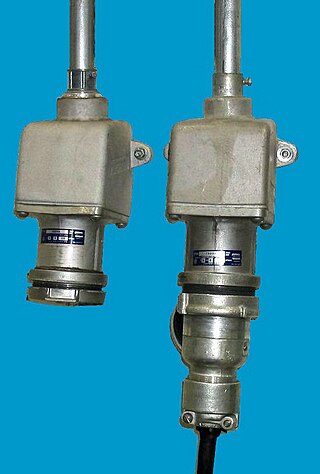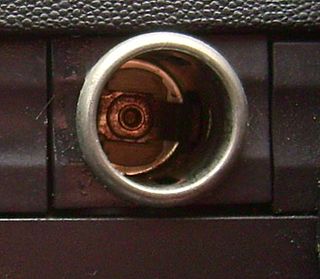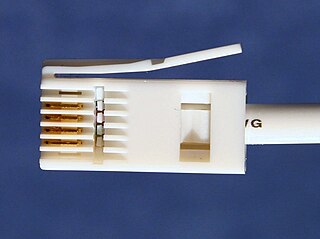
An electrical outlet tester, receptacle tester, or socket tester is a small device containing a 3-prong power plug and three indicator lights, used for quickly detecting some types of incorrectly-wired electrical wall outlets or campsite supplies.

An electrical outlet tester, receptacle tester, or socket tester is a small device containing a 3-prong power plug and three indicator lights, used for quickly detecting some types of incorrectly-wired electrical wall outlets or campsite supplies.

The outlet tester checks that each contact in the outlet appears to be connected to the correct wire in the building's electrical wiring. It can identify several common wiring errors, including swapped phase and neutral, and failure to connect ground.
The tester confirms continuity and polarity of the electrical connections, but it does not verify current-carrying ability, [1] electrical safety (which requires impedance testing), [2] insulation breakdown voltage, or loop connection of ring mains. [3]
Simple three-light testers cannot detect some potentially serious house wiring errors, including neutral and ground interchanged at the receptacle. There may be a "bootleg ground", where the neutral and ground pins have been connected together at the receptacle, which cannot be detected either. [4] These problems can be detected with a multimeter and a test load, to verify that the ground connection is separate from the neutral and is not carrying normal circuit return current, or more typically by using a more-sophisticated multifunction tester. [4]
A quick supplemental screening test for these simple miswiring errors can be performed using a non-contact voltage tester (NCVT) or non-contact voltage detector. [4] If a problem is thus identified, it can be investigated further using more-advanced equipment, or the outlet in question can be de-energized and disassembled for careful scrutiny. [4]
Some receptacle testers include an additional test button to test the triggering of GFCI devices, which supplements the built-in test button on the GFCI and can be used for testing outlets downstream from a GFCI receptacle. "Plug-in analyzers" may include earth loop impedance and other checks. [5] : 48–49
An early reference that describes the typical outlet tester circuit was published in Popular Mechanics in the March issue of 1967, and consists of two 27 kΩ resistors, one 100 kΩ resistor, and three NE-51 neon lamp bulbs with 100 kΩ resistors. [6]

In electrical engineering, ground or earth may be a reference point in an electrical circuit from which voltages are measured, a common return path for electric current, or a direct physical connection to the Earth.
Electrical wiring in North America follows the regulations and standards applicable at the installation location. It is also designed to provide proper function, and is also influenced by history and traditions of the location installation.

A residual-current device (RCD), residual-current circuit breaker (RCCB) or ground fault circuit interrupter (GFCI) is an electrical safety device that interrupts an electrical circuit when the current passing through a conductor is not equal and opposite in both directions, therefore indicating leakage current to ground or current flowing to another powered conductor. The device's purpose is to reduce the severity of injury caused by an electric shock. This type of circuit interrupter cannot protect a person who touches both circuit conductors at the same time, since it then cannot distinguish normal current from that passing through a person.

The National Electrical Code (NEC), or NFPA 70, is a regionally adoptable standard for the safe installation of electrical wiring and equipment in the United States. It is part of the National Fire Code series published by the National Fire Protection Association (NFPA), a private trade association. Despite the use of the term "national," it is not a federal law. It is typically adopted by states and municipalities in an effort to standardize their enforcement of safe electrical practices. In some cases, the NEC is amended, altered and may even be rejected in lieu of regional regulations as voted on by local governing bodies.

An arc-fault circuit interrupter (AFCI) or arc-fault detection device (AFDD) is a circuit breaker that breaks the circuit when it detects the electric arcs that are a signature of loose connections in home wiring. Loose connections, which can develop over time, can sometimes become hot enough to ignite house fires. An AFCI selectively distinguishes between a harmless arc, and a potentially dangerous arc.
In an electrical system, a ground loop or earth loop occurs when two points of a circuit are intended to have the same ground reference potential but instead have a different potential between them. This is typically caused when enough current is flowing in the connection between the two ground points to produce a voltage drop and cause the two points to be at different potentials. Current may be produced in a ground loop by electromagnetic induction.

Industrial and multiphase plugs and sockets provide a connection to the electrical mains rated at higher voltages and currents than household plugs and sockets. They are generally used in polyphase systems, with high currents, or when protection from environmental hazards is required. Industrial outlets may have weatherproof covers, waterproofing sleeves, or may be interlocked with a switch to prevent accidental disconnection of an energized plug. Some types of connectors are approved for hazardous areas such as coal mines or petrochemical plants, where flammable gas may be present.

In electrical engineering, ground and neutral are circuit conductors used in alternating current (AC) electrical systems. The neutral conductor receives and returns alternating current to the supply during normal operation of the circuit; to limit the effects of leakage current from higher-voltage systems, the neutral conductor is often connected to earth ground at the point of supply. By contrast, a ground conductor is not intended to carry current for normal operation, but instead connects exposed metallic components to earth ground. A ground conductor only carries significant current if there is a circuit fault that would otherwise energize exposed conductive parts and present a shock hazard. In that case, circuit protection devices may detect a fault to a grounded metal enclosure and automatically de-energize the circuit, or may provide a warning of a ground fault.
Electrical wiring in the United Kingdom is commonly understood to be an electrical installation for operation by end users within domestic, commercial, industrial, and other buildings, and also in special installations and locations, such as marinas or caravan parks. It does not normally cover the transmission or distribution of electricity to them.
An earthing system or grounding system (US) connects specific parts of an electric power system with the ground, typically the equipments conductive surface, for safety and functional purposes. The choice of earthing system can affect the safety and electromagnetic compatibility of the installation. Regulations for earthing systems vary among countries, though most follow the recommendations of the International Electrotechnical Commission (IEC). Regulations may identify special cases for earthing in mines, in patient care areas, or in hazardous areas of industrial plants.

AS/NZS 3112 is the harmonised/joint Australian and New Zealand Standard for AC power plugs (male) and sockets (female). The standard is used in Australia, New Zealand, Fiji, Tonga, Solomon Islands, Papua New Guinea and several other Pacific island countries. In Argentina and China an almost-identical design is also used, but these are separate standards, despite their appearance. The International Electrotechnical Commission (IEC) "world plugs" website defines this design as Plug Type I'.

A test light, test lamp, voltage tester, or mains tester is a piece of electronic test equipment used to determine the presence of electricity in a piece of equipment under test. A test light is simpler and less costly than a measuring instrument such as a multimeter, and often suffices for checking for the presence of voltage on a conductor. Properly designed test lights include features to protect the user from accidental electric shock. Non-contact test lights can detect voltage on insulated conductors.

NEMA connectors are power plugs and sockets used for AC mains electricity in North America and other countries that use the standards set by the US National Electrical Manufacturers Association. NEMA wiring devices are made in current ratings from 15 to 60 amperes (A), with voltage ratings from 125 to 600 volts (V). Different combinations of contact blade widths, shapes, orientations, and dimensions create non-interchangeable connectors that are unique for each combination of voltage, electric current carrying capacity, and grounding system.

In electrical safety testing, portable appliance testing is a process by which electrical appliances are routinely checked for safety, commonly used in the United Kingdom, Ireland, New Zealand and Australia. The formal term for the process is "in-service inspection & testing of electrical equipment". Testing involves a visual inspection of the equipment and verification that power cables are in good condition. Additionally, other tests may be done when required, such as a verification of earthing (grounding) continuity, a test of the soundness of insulation between the current-carrying parts, and a check for any exposed metal that could be touched. The formal limits for a pass/fail of these electrical tests vary somewhat depending on the category of equipment being tested.

An automobile auxiliary power outlet in an automobile was initially designed to power an electrically heated cigarette lighter, but became a de facto standard DC connector to supply electrical power for portable accessories used in or near an automobile directly from the vehicle's electrical system. Such include mobile phone chargers, cooling fans, portable fridges, electric air pumps, and power inverters.

Stray voltage is the occurrence of electrical potential between two objects that ideally should not have any voltage difference between them. Small voltages often exist between two grounded objects in separate locations by the normal current flow in the power system. Contact voltage is a better defined term when large voltage appear as a result of a fault. Contact voltage on the enclosure of electrical equipment can appear from a fault in the electrical power system, such as a failure of insulation.

British telephone sockets were introduced in their current plug and socket form on 19 November 1981 by British Telecom to allow subscribers to connect their own telephones. The connectors are specified in British Standard BS 6312. Electrical characteristics of the telephone interface are specified by individual network operators, e.g. in British Telecom's SIN 351. Electrical characteristics required of British telephones used to be specified in BS 6305.

A cheater plug, AC ground lifter or three-prong/two-prong adapter is an adapter that allows a NEMA 5-15P grounding-type plug to connect to a NEMA 1-15R non-grounding receptacle. They are needed to allow appliances with 3-wire power cords to plug into legacy ungrounded receptacles found in older buildings. The use of such an adapter avoids the need to replace receptacles, but is potentially hazardous if the grounding tab is not connected to electrical ground. These adapters are illegal in some jurisdictions, in particular throughout Canada. A safer and more reliable alternative identified in the US and Canadian electrical codes is to replace the outlet with a Ground Fault Circuit Interrupter (GFCI) breaker outlet.

In building wiring installed with separate neutral and protective ground bonding conductors, a bootleg ground is a connection between the neutral side of a receptacle or light fixture and the ground lug or enclosure of the wiring device.
A GCM or ground continuity monitor is an electrical safety device that monitors the impedance to ground of a temporary electrical circuit and can provide indication in the event impedance rises to an unsafe value. A GCM is either an external testing device or a cord mounted device that measures the electrical continuity of a circuit’s path to ground.